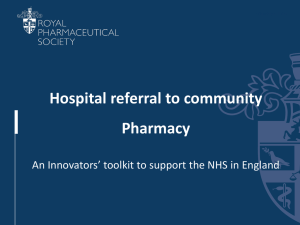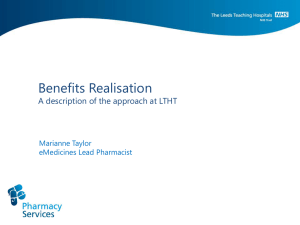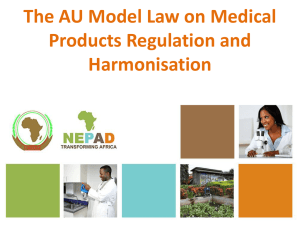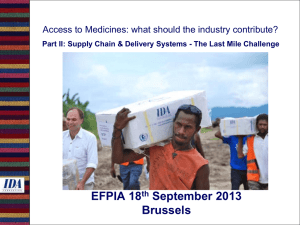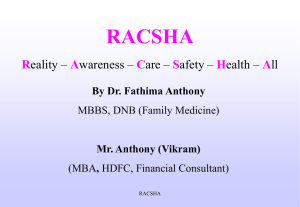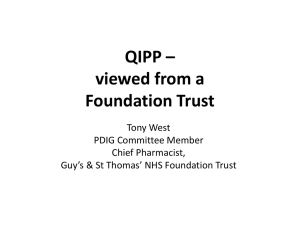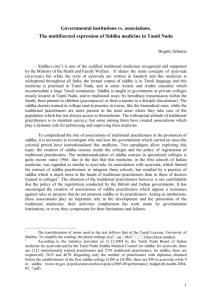Mr. T. C. James
advertisement
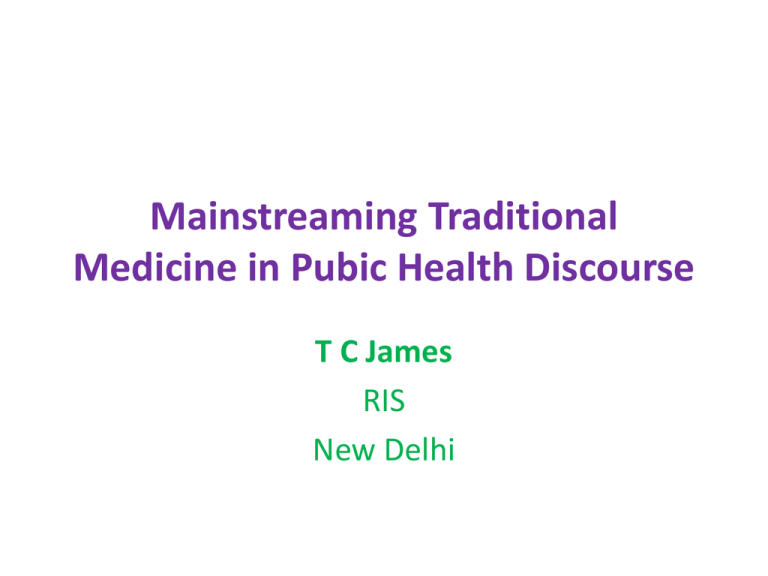
Mainstreaming Traditional Medicine in Pubic Health Discourse T C James RIS New Delhi Achievement of universal health care is a major concern 2 Key Facts - 1 • 8.8 million children under 5 years of age died in 2008 – 60.99 deaths per 1000 in 2009 – 40 % deaths in the first month • 104 million (i.e., 16 %) children under nourished (2010) • Less than 50 % child births assisted by skilled health worker • 33.3 million persons with AIDS, of which 2.4 m. in India – 2.7 million new cases in 2008 – 2 million HIV/AIDS related deaths in 2008 3 Key Facts- 2 • 14 million TB cases – 1.9 million TB related deaths in 2009] • 247 million cases of malaria (2009) – 1 million deaths malaria related deaths (2008) – In Africa a child dies every 45 seconds of malaria – Malaria accounts for 25 % all child deaths • 1 billion people suffer from neglected tropical diseases – 190,130 cases of cholera reported in 2008 – 213, 036 cases of leprosy were reported in 2009 Miles to go and miles to go… 4 Millennium Development Goals: Health (2000) • The Millennium Development Goals to achieve by the year 2015 include: Reduction of child mortality rate; Improvement of maternal health; Combating successfully HIV/AIDS, malaria, and other diseases. 5 Issues in Public health • Availability of Human Resources • Inequities in – Availability – Accessibility – Affordability of Medicines 6 7 Number of Physicians per 10,000 Population Country Number Country Number Russia 43 Argentina 32 Norway 39 Mexico 29 Spain 38 Brazil 17 France 37 China 14 Germany 35 Iran 9 USA 27 India 6 UK 21 Sudan 3 Japan 21 Indonesia 1 Australia 10 Kenya 1 8 Availability of Medicines • The availability of medicines for both acute and chronic conditions suboptimal across countries, particularly in the public sector • Generics for chronic diseases were significantly less available than those for acute conditions in both the public (36% vs. 53.5%) and the private sector (54.7% vs. 66.2%). – From a study by Alexandra Cameron of 30 commonly used drugs in 40 low and middle income countries 9 Affordability of Medicines - 1 • In developing countries, most medicines are paid for out-of-pocket by individual patients rather than through social security systems. • 86 % of population would be pushed into poverty as a result of purchasing medicines (WHO study in 16 countries) 10 Affordability of Medicines - 2 • Prices people pay for lowest priced generic medicines vary from 2.5 times to 6.5 times the international reference prices in case of HIV, TB & Malaria drugs • High prices are a barrier to use of medicines and health products. 11 Access to Medicines • Access: “Having medicines continuously available at public or private health facilities or medicine outlets that are within one hour’s walk from the homes of the population.” (UNDP) Countries Access level 53 countries (Developed world, Sri Lanka, Korea) 95% 37 countries (Indonesia, Iran, China) 80 % 47 countries (Philippines, Malaysia, Pakistan) 50 % 25 countries (India, Kenya, Ghana, Brazil, Cambodia) 0% 12 Tackling the Problem • Modern Medicine alone may find it difficult to take care of public health in all countries • Need a holistic approach involving traditional medicines also. 13 Traditional Medicine • “Traditional medicine refers to health practices, approaches, knowledge and beliefs incorporating plant, animal and mineral based medicines, spiritual therapies, manual techniques and exercises, applied singularly or in combination to treat, diagnose and prevent illnesses or maintain well-being.” (WHO) 14 Traditional Medicine: A Living Tradition/Science • • • • • • Traditional Medicine not static, but evolving Traditional vs ‘Modern science’ Multiplicity of systems Heterogeneity vs. Homogeneity Macro -- Micro Body, mind, soul 15 Understanding Traditional Medicine • Holistic system that treats the whole person • Medicines based on basic elements which are materialized in genetic resources and environment • Sustainability of traditional medicine depends on protection of environment and biological diversity conservation 16 Importance of Traditional Medicine • TM plays an important role in meeting primary health care needs in developing countries • 1/3rd of population have no regular access to modern medicine • Around 80 per cent in developing countries rely on traditional medicine • In India, 36.6 % child deliveries are managed by traditional birth attendants 17 Usage of Traditional Medicine Country Usage of TM Country Usage of TM Ethiopia 90 % Canada 70 % Benin 80 % France 49 % India 70 % Australia 48 % Rwanda 70 % USA 42 % Tanzania 60 % Belgium 31 % Uganda 60 % 18 Rationale for Using TM • Cost Factor • Accessibility Factor • Cultural Factor 19 Cost Factor • In developing countries, generally traditional medicine is cheaper compared to modern medicine • In developed countries high income population access traditional medicine • Also low income ethnic groups from developing countries 20 Cultural and Environmental Factors • Traditional Medicines are from locally available plants, herbs and minerals and knowledge • People are more used to them • No side effects generally 21 Accessibility Factor • Ratio between traditional healer to population in Africa varies from 1:200 to 1:400 • Ratio between allopathic practitioners and population is 1:20,000 22 Challenges • Quality, standardisation, safety, issues • Access to natural resources for raw materials • Sustainable use of natural resources 23 Traditional Medicines in India • Formal Ayurveda Body consists of 5 elements, viz. earth, water, fire, air and vacuum and illness a disturbance in the 3 humours, viz., vata, pitta, & kapha, constituted by the 5 elements Medicines mostly herbal. Siddha Use herbs, metals and minerals Unani A Greco-Arab system Yoga Breath control and regulated poses • Informal 24 Indian Approach to Traditional Medicine • Protection, Development and Use • Certain states have taken steps to integrate traditional medicine in their public health programmes – E.g. Use of Siddha medicines in Chikungunya epidemic in Tamil Nadu 25 Some Statistics: Ayurveda (2008) • • • • • • Hospitals - 2416 Beds - 43,710 Dispensaries -- 13,989 Registered Practitioners -- 460,001 Colleges -- 305 Pharmacies -- 7910 26 Some Statistics - Siddha (2008) • • • • • • Hospitals - 276 Beds - 2586 Dispensaries -- 529 Registered Practitioners -- 6687 Colleges -- 10 Pharmacies -- 302 27 Some Statistics - Unani (2008) • • • • • • Hospitals - 268 Beds - 4686 Dispensaries -- 1028 Registered Practitioners -- 47,963 Colleges -- 46 Pharmacies -- 324 28 Registered Medical Practitioners in India (2006) System Registered Medical Practitioners Allopathy 662,646 Ayurveda 453,661 Siddha Unani 6381 46,558 • 43.32 % of registered practitioners belong to 3 TM streams 29 Use of Traditional Medicine • Alternative? • Complementary? 30 Need a Fresh Approach to Public Health Issues • Need to recognise and effectively use Traditional Medicines too • Integration with public health programmes • Recognition of Traditional Medicine pharmacopoeia • Put TM on the same footing as Allopathy • Insurance coverage? • Sensitization of health workers, policy makers and general public 31 Declaration of Alma-Ata 1978 • “Primary health care: (inter alia) – relies, at local and referral levels, on health workers, including physicians, nurses, midwives, auxiliaries and community workers as applicable, as well as traditional practitioners as needed, suitably trained socially and technically to work as a health team and to respond to the expressed health needs of the community.” Use of traditional medicine for public health programmes is in accordance with WHO Alma-Ata Declaration 32 Thank You E-mail: tcj@nic.in 33


